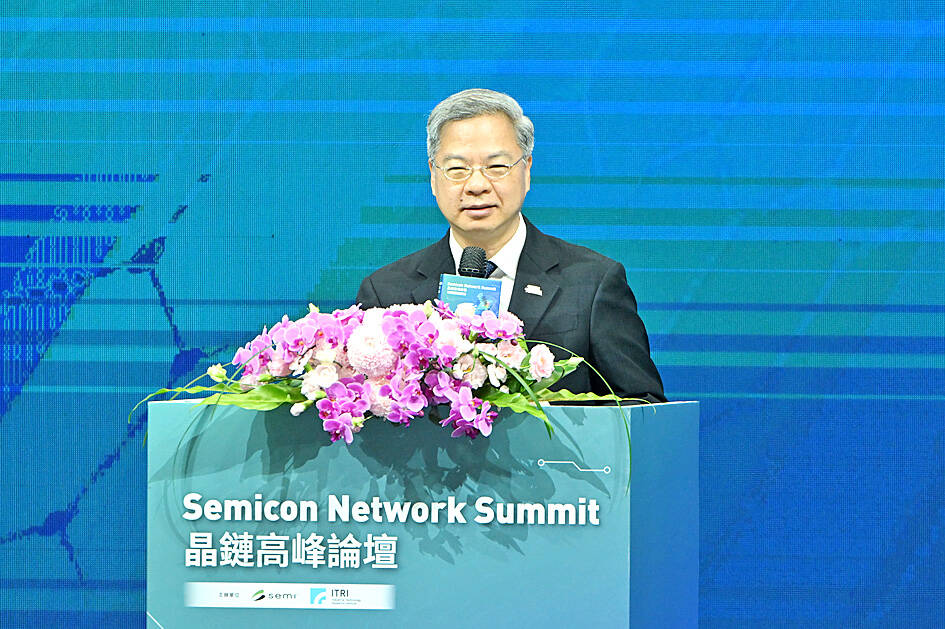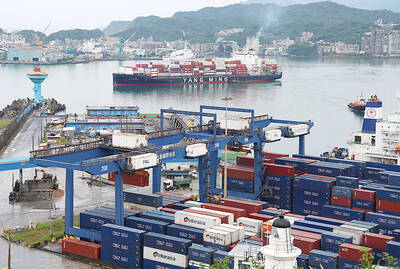Challenges to the global semiconductor supply chain, including geopolitical tensions, extreme weather, limited access to key materials and unstable demand, have tested the industry’s resilience and capacity for cooperation, Minister of Economic Affairs Kung Ming-hsin (龔明鑫) said yesterday.
To address these challenges, the semiconductor industry should cooperate in three areas: working together as globalization is restructured, co-developing advanced technologies and sharing information through communication platforms, Kung said at a forum in Taipei ahead of the Semicon Taiwan trade show that is scheduled to open today.
The forum featured industry representatives, including SEMI International Board chairman Tien Wu (吳田玉), Merck Group Taiwan managing director John Lee (李俊隆), Applied Materials Inc vice president of engineering Chen Jang-fung (陳正方) and Micron Memory Japan vice president Kota Nosaka.

Photo: Tien Yu-hua, Taipei Times
Amid geopolitical regulatory uncertainty, it is important to consider how multinational corporations can work together to identify the most efficient path forward, Wu said.
Each country and company must be strong, but in a complex environment, simplified solutions are key, Wu said, adding that history shows those who optimize and simplify are more likely to survive.
While Taiwan produces about 90 percent of the world’s artificial intelligence (AI) chips, its share of next-generation silicon photonics remains unclear, but demand for the technology is expected to grow as AI infrastructure expands, Wu said.
The technology requires decade-long planning to realize the industry’s vision, and as the number of transistors per chip continues to grow, power supply and management could emerge as the next bottleneck in developing chip-on-wafer-on-substrate (CoWoS) and 3D integrated circuit packaging, he said.
As the semiconductor industry shifts toward regionalization and localization, it can simplify global operations, strengthen supply chain resilience and reduce international material transport, while also lowering its overall carbon footprint and enhancing customer satisfaction, Lee said.
Meanwhile, Chen said Applied Materials regards Taiwan as having three major advantages: its proximity to customers, strong manufacturing teams and abundant local talent.
Those factors are why that nation should act as a strategic coordinator to balance upstream material supply with downstream testing and packaging, Chen said.
The nation’s semiconductor expertise could also be applied to quantum computing, he said.
Kung said in conclusion that as Taiwan’s industry clusters are highly concentrated, they provide high production efficiency.
The industry should stay rooted in Taiwan while maintaining a global focus, he said, adding that the nation is willing to share its experience with the world.

CHIP RACE: Three years of overbroad export controls drove foreign competitors to pursue their own AI chips, and ‘cost US taxpayers billions of dollars,’ Nvidia said China has figured out the US strategy for allowing it to buy Nvidia Corp’s H200s and is rejecting the artificial intelligence (AI) chip in favor of domestically developed semiconductors, White House AI adviser David Sacks said, citing news reports. US President Donald Trump on Monday said that he would allow shipments of Nvidia’s H200 chips to China, part of an administration effort backed by Sacks to challenge Chinese tech champions such as Huawei Technologies Co (華為) by bringing US competition to their home market. On Friday, Sacks signaled that he was uncertain about whether that approach would work. “They’re rejecting our chips,” Sacks

Taiwan’s exports soared 56 percent year-on-year to an all-time high of US$64.05 billion last month, propelled by surging global demand for artificial intelligence (AI), high-performance computing and cloud service infrastructure, the Ministry of Finance said yesterday. Department of Statistics Director-General Beatrice Tsai (蔡美娜) called the figure an unexpected upside surprise, citing a wave of technology orders from overseas customers alongside the usual year-end shopping season for technology products. Growth is likely to remain strong this month, she said, projecting a 40 percent to 45 percent expansion on an annual basis. The outperformance could prompt the Directorate-General of Budget, Accounting and

NATIONAL SECURITY: Intel’s testing of ACM tools despite US government control ‘highlights egregious gaps in US technology protection policies,’ a former official said Chipmaker Intel Corp has tested chipmaking tools this year from a toolmaker with deep roots in China and two overseas units that were targeted by US sanctions, according to two sources with direct knowledge of the matter. Intel, which fended off calls for its CEO’s resignation from US President Donald Trump in August over his alleged ties to China, got the tools from ACM Research Inc, a Fremont, California-based producer of chipmaking equipment. Two of ACM’s units, based in Shanghai and South Korea, were among a number of firms barred last year from receiving US technology over claims they have

BARRIERS: Gudeng’s chairman said it was unlikely that the US could replicate Taiwan’s science parks in Arizona, given its strict immigration policies and cultural differences Gudeng Precision Industrial Co (家登), which supplies wafer pods to the world’s major semiconductor firms, yesterday said it is in no rush to set up production in the US due to high costs. The company supplies its customers through a warehouse in Arizona jointly operated by TSS Holdings Ltd (德鑫控股), a joint holding of Gudeng and 17 Taiwanese firms in the semiconductor supply chain, including specialty plastic compounds producer Nytex Composites Co (耐特) and automated material handling system supplier Symtek Automation Asia Co (迅得). While the company has long been exploring the feasibility of setting up production in the US to address